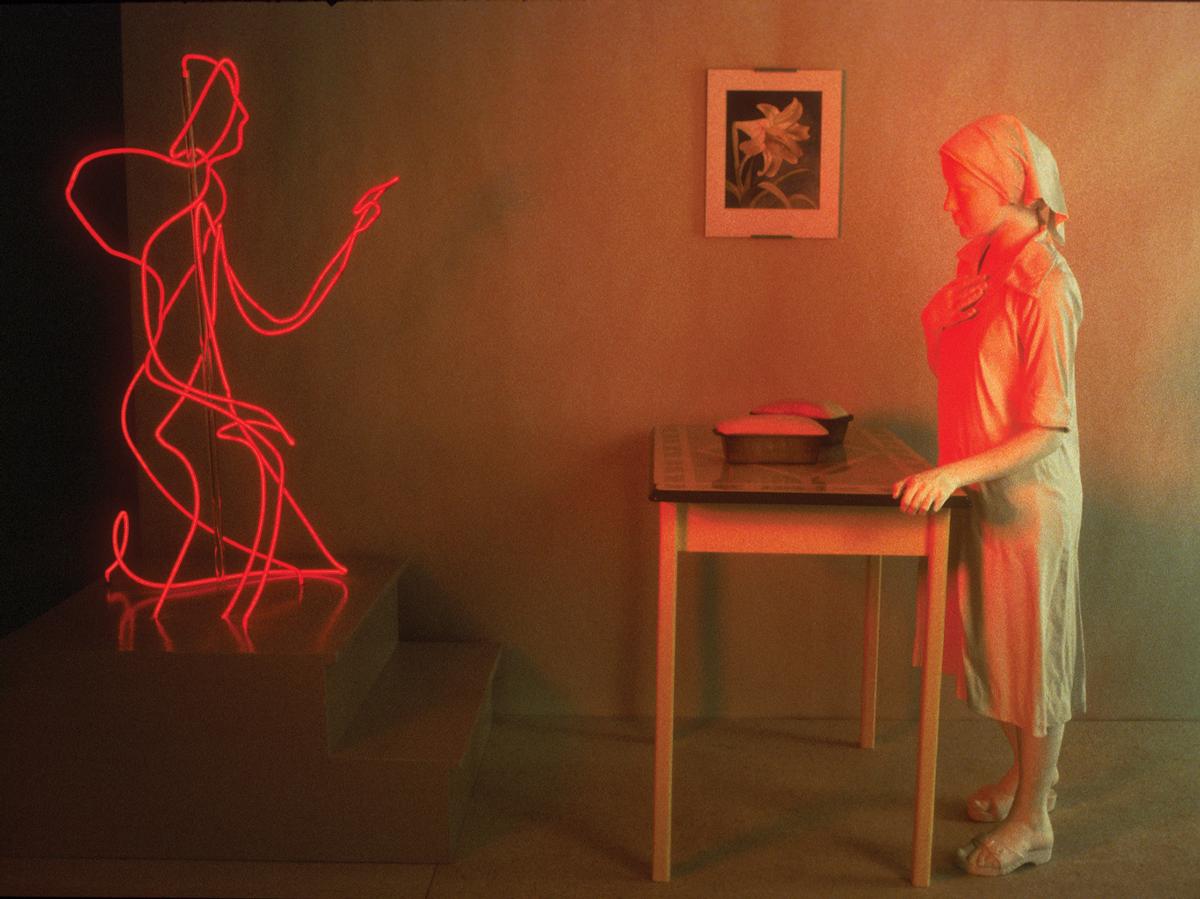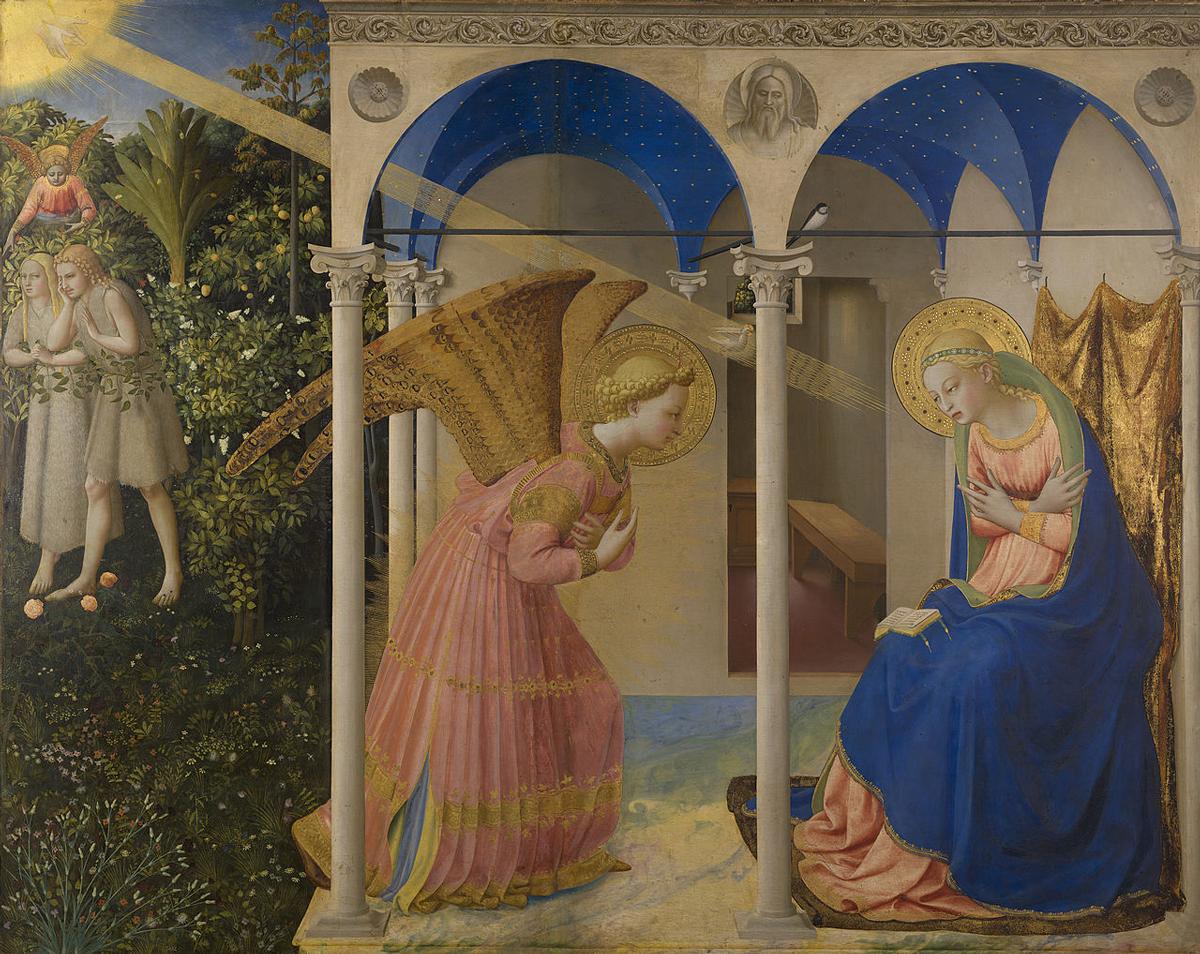December 15: Annunciation
♫ Music:
Day 16—Monday, December 15
Now in the sixth month the angel Gabriel was sent from God to a city in Galilee called Nazareth, to a virgin engaged to a man whose name was Joseph, of the descendants of David; and the virgin’s name was Mary. And coming in, he said to her, “Greetings, favored one! The Lord is with you.” But she was very perplexed at this statement, and kept pondering what kind of salutation this was. The angel said to her, “Do not be afraid, Mary; for you have found favor with God. And behold, you will conceive in your womb and bear a son, and you shall name Him Jesus. He will be great and will be called the Son of the Most High; and the Lord God will give Him the throne of His father David; and He will reign over the house of Jacob forever, and His kingdom will have no end.” Mary said to the angel, “How can this be, since I am a virgin?” The angel answered and said to her, “The Holy Spirit will come upon you, and the power of the Most High will overshadow you; and for that reason the holy Child shall be called the Son of God. And behold, even your relative Elizabeth has also conceived a son in her old age; and she who was called barren is now in her sixth month. For nothing will be impossible with God.” And Mary said, “Behold, the bondslave of the Lord; may it be done to me according to your word.” And the angel departed from her.
Luke 1:26-38
The Annunciatory Angel
Luci Shaw
(while looking at a detail of Fra Angelico’s The Annunciation)
The androgynous visitor is dressed
in a rosy fabric thick as pigment, the tunic
blown back by turbulence to expose its lining,
a blue crescent under the right arm. Angels
are said to be genderless, so there’s a certain
enigma. A wing, the clue to otherness,
arcs in golden space. We are
at several removes from the reality, reading
between the lines, speculating on Angelico’s
speculation. How does an angel look? We are not
Daniel or Zechariah; we have not been shown.
This rendering suggests not celestial power and radiance
but a weight of apprehension; what must be announced
will not be entirely easy news.
Wind is part of the picture, gusts
whipping the robes and body along a stretch
of baroque carpet. Gabriel seems to be
advancing up an incline, laboring with
the imperative of message, hair flattened against scalp,
features tense, hands folded tight to the chest,
agitation or awe—it is hard to tell. We can’t see
the heart hammering in the unearthly body,
but the announcement, the cracking open of a space
that encircled earth and heaven, must weigh
like a gold boulder in the belly.
How might it feel (if an archangel has feelings) to bear
this news? Perhaps as confounded as the girl, there
in the corner? We worry that she might faint.
Weep. Turn away, perplexed and fearful
about opening herself. Refuse to let the wind
fill her, to buffet its nine-month seed into her earth.
She is so small and intact. Turmoil will wrench her.
She might say no.
Announcement
Luci Shaw
Yes, we have seen the studies, sepia strokes
across yellowed parchment, the fine detail
of hand and breast and the fall of cloth—
Michelangelo, Caravaggio, Titian, El Greco,
Rouault—each complex Madonna plotted at last
on canvas, layered with pigment, like the final
draft of a poem after thirty-nine roughs.
But Mary, virgin, had no sittings, no chance
to pose her piety, no novitiate for body or
for heart. The moment was on her unaware:
the Angel in the room, the impossible demand,
the response without reflection. Only one
word of curiosity, echoing Zechariah’s How?
yet innocently voiced, without request for proof.
The teen head tilted in light, the hand
trembling a little at the throat, the candid
eyes, wide with acquiescence to shame and glory—
“Be it unto me as you have said.”
Shaw, Luci. "The Annunciatory Angel." & “Announcement.” Accompanied by Angels: Poems of the Incarnation. Grand Rapids, MI: William B. Eerdmans Pub., 2006. 3-4, 8
Prayer
Lord Jesus Christ,
Eternal Word,
You became Incarnate as man
in the womb of the Blessed Virgin Mary.
You, through whom the universe was created,
began your earthly course,
in the womb of a humble and chaste Virgin.
At the annunciation of this miracle,
Mary responded in faith:
"let it be done to me
according to your word."
May we who are made new creatures
by your grace,
respond with such faith,
when you call us to your service.
Amen
The Annunciation
Theodore Prescott
1978-79
Cast hydrocal, neon, wood, found objects, life-size figure
Annunciation
Fra Angelico
1430
Tempera on panel
About the Artist and Art (Piece 1)
Theodore Prescott is an American sculptor and writer. He founded the art department at Messiah College in Grantham, PA in 1980, and served as chair of the department for a decade. He was also a major figure in founding the national organization Christians in the Visual Arts (CIVA). His works have been exhibited in the US and Europe, and in public and private collections. He works in traditional sculptural mediums, but also enjoys using unconventional media. His Annunciation depicts the moment when the angel Gabriel visits Mary to tell her that she will miraculously conceive and be the mother of the Messiah.
http://tedprescottsculpture.com/
About the Artist and Art (Piece 2)
Fra Angelico (c. 1395 – 1455) was an Early Italian Renaissance painter. His altarpieces, frescoes, and paintings of various saints were conservatively Gothic and progressively Renaissance—his backgrounds contained all the finery and gold gilding one would expect, while his robed figures had a three-dimensionality and realism that made them squarely Renaissance.
About the Music (Piece 1)
Ave Maria Lyrics
Ave Maria, gratia plena
Sancta Maria gratia
Ave Maria, mater Dei
Maria, ora pro nobis
Maria, pro nobis
Ave Maria, mater Dei
Maria, ora pro nobis
Maria, pro nobis
Ora, ora
Ora pro nobis
Ave Maria, gratia plena
Sancta Maria gratia
Ave Maria, mater Dei
Maria, ora pro nobis
Maria, pro nobis
(English Translation)
Hail Mary, full of grace
Holy Mary of Grace
Hail Mary, Mother of God
Mary, Pray for us
Mary, for us
About the Composer
While Ave Maria is often attributed to Baroque composer Guilio Caccini, it was in fact composed by Vladimir Vavilov (1925 – 1973) in 1970. Vavilov often ascribed his own works to composers from earlier periods, and they are still widely circulated and performed.
About the Performers
Libera, directed by Robert Prizeman, is an all-boys choir from South London. They began as the choir of St. Philips, Norbury, but have been known as Libera since 1999. Prizeman’s compositions for the choir combine elements from classical as well as contemporary music.
http://www.libera.org.uk/
About the Music (Piece 2)
Awed by the Beauty Lyrics
Awed by the beauty
Of your virginity
And the exceeding radiance
Of your purity.
Gabriel stood amazed
And cried to you "oh mother of God
What praise may I offer you
That is worthy of your beauty?
By what name shall I call you?”
I am lost and bewildered
But I shall greet you as I was commanded.
You who are full of grace.
About the Performers
Eikona is made up of three sisters who originally decided to record some of their favorite hymns as a gift to their parents. They have now been recording Greek Orthodox services, hymns, and original compositions for over fifteen years.
www.eikona.com/
About the Poet
Luci Shaw (b. 1928) is a Christian poet. Shaw studied at Wheaton College, Illinois and is now Writer in Residence at Regent College, Vancouver. She lectures on art and spirituality, the Christian imagination, poetry-writing, and journaling as an aid to artistic and spiritual growth. She has published ten volumes of poetry and numerous non-fiction books, and has edited and collaborated on multiple other works, including several with Madeleine L'Engle. Shaw usually works in free verse, and typically her poems are quite short, less than a page. Nevertheless, in tone and content, she affiliates most readily with the transcendental poets, often finding in natural details and themes the touch of the eternal or other-worldly.
http://www.lucishaw.com/poetry.html

